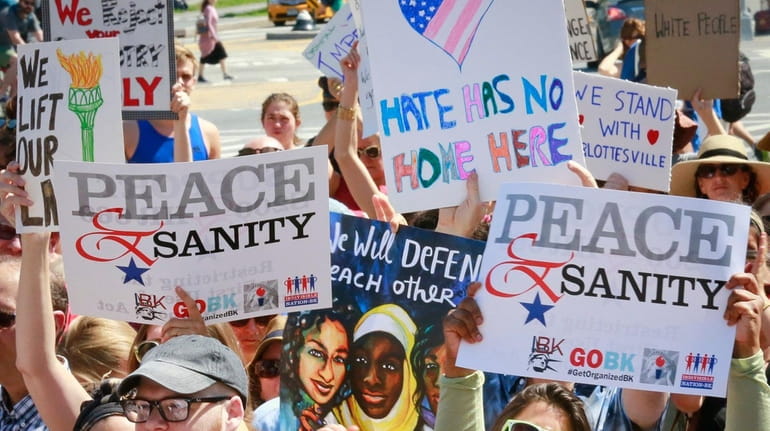The Civil War, race and the whitewashing of history

Protesters listen during a "Peace and Sanity" rally Sunday Aug. 13, 2017, in Brooklyn, during a rally about white supremacy violence in Charlottesville, Va. Credit: AP / Bebeto Matthews
President Donald Trump has been roundly condemned over the last few days for failing to specifically denounce white supremacists who descended on Charlottesville, Virginia, to protest the plan to remove a statue of Confederate general Robert E. Lee.
After a reported neo-Nazi drove his car into a crowd, killing one and injuring dozens of others, Trump weakly said he objected to violence “on many sides.”
The White House eventually released an unsigned statement that Trump’s condemnation of “all forms of violence, bigotry, and hatred” included “white supremacists, K.K.K. neo-Nazis, and all extremist groups.” But even that comment seemed to equate the bigots with the people who had assembled to challenge them. And at no point did the president himself name the defenders of the Lee memorial for what they were: white racists.
That’s a whitewash of history, of course, just like the statue of Robert E. Lee is. Yet when the smoke clears from Charlottesville, I hope the statue remains. Removing it would constitute yet another whitewash, allowing us to airbrush out the bigotry that brought it into being.
Over the past few years, Confederate memorials have been removed in New Orleans, Austin, and several other cities. But most Americans probably imagine that the memorials date from the Civil War, and that they’re exclusive to the South.
Wrong and wrong. The vast majority of Conference memorials — including the Lee statue in Charlottesville — were erected in the early 20th century, when Southern whites established a new form of racial supremacy: Jim Crow. African-Americans were segregated by law, stripped of their voting rights, and lynched when they got out of line.
And that required a new set of stories about the Civil War, which was re-imagined as a “War Between the States.” White leaders like Lee became avuncular defenders of the region’s “Lost Cause,” not cruel racists who enslaved millions of black people.
That was also a convenient story for racists in the North and West, which contained large numbers of Confederate veterans and sympathizers. The northernmost Confederate monument is a fountain in Helena, Montana, erected in 1916 to praise “the present day American spirit . . . with no feeling between the old North and South that caused such bitterness and sorrow years ago,” one local advocate declared.
Six months earlier, D.W. Griffith’s “The Birth of a Nation” had played to packed houses in Helena. It lionized the Ku Klux Klan for protecting white womanhood from savage African-Americans, who were obviously omitted from the new spirit of white unity that the fountain celebrated.
Following the 2015 church shootings in Charleston, South Carolina, the Helena fountain added a sign explaining how it came into being. “We look at the nation’s racial problems as distant from us,” a city council member explained. “But the fountain shows that we, too, played our role in Jim Crow.”
That goes for all of us, wherever we live. The Lee memorial in Charlottesville isn’t a testament to Southern honor, as its racist defenders continue to claim. It’s a reminder of the many ways that racism has been rebranded over the years, in the vain effort to make us forget it.
Rather than removing the Lee statue, then, I hope the city erects a new memorial to Heather D. Heyer, the 32-year-old paralegal who was killed on Saturday. We have a deep history of white supremacy in this country, whether our president recognizes it or not. Rest in peace, Ms. Heyer. We will remember you, and the hatred that you challenged.
Jonathan Zimmerman teaches education and history at the University of Pennsylvania. He is the co-author of “The Case for Contention: Teaching Controversial Issues in American Schools.”
